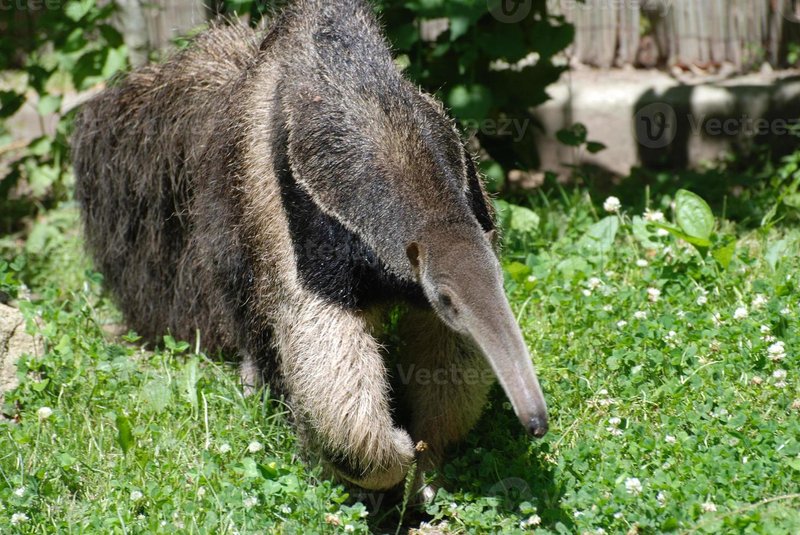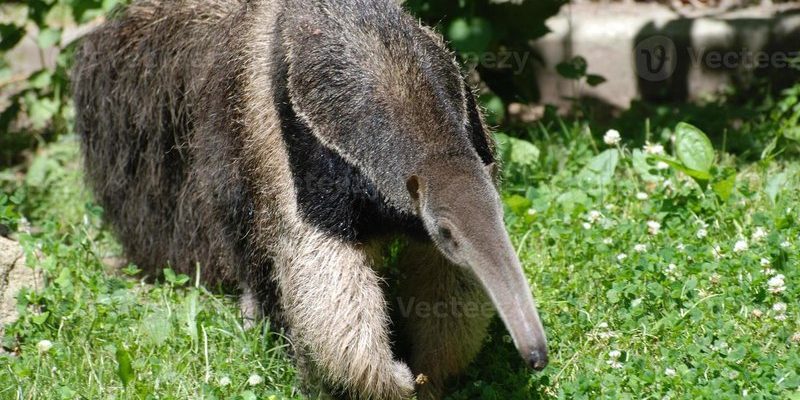
Have you ever seen a creature that looks like it walked straight out of a fantasy novel? The Giant Anteater is one of those fascinating animals that seems to belong in a storybook. With its long snout, protective armor-like fur, and remarkable tongue, this animal captures the imagination. You might think of it as nature’s very own vacuum cleaner, designed specifically for one purpose: munching on ants and termites.
What’s truly captivating about the Giant Anteater is not just its appearance, but its behavior and habitat as well. Found primarily in Central and South America, these creatures have adapted to a variety of environments—from lush rainforests to grassy savannas. Everyday life for a Giant Anteater involves roaming vast distances in search of their favorite snacks, using those incredible skills to find food in places you might never expect.
Physical Characteristics
The Giant Anteater is a true standout in the animal kingdom. They can reach lengths of up to 7 feet, including their long, slender tail. Just imagine them striding through the dense foliage, looking for their next meal. Their fur is coarse and bristly, providing them with protection against sharp ant bites. Most notably, their long snout—shaped almost like a delicate tube—houses their unique tongue, which can extend up to 16 inches long. This remarkable adaptation allows them to reach deep into ant hills and termite mounds.
Another striking feature is their sharp claws. These claws are not only for digging but also serve as a defense mechanism. If threatened, a Giant Anteater can stand on its hind legs and swipe at potential predators, showcasing its size and strength. However, they are generally peaceful creatures and prefer to avoid confrontation whenever possible.
Habitat and Distribution
The Giant Anteater thrives in a variety of habitats across Central and South America. They are commonly found in rainforests, savannas, and scrublands, as long as these environments provide their main food sources: ants and termites. While they can adapt to different surroundings, they prefer areas with abundant vegetation that also provide a sense of cover from predators.
These incredible creatures can be found in countries such as Brazil, Paraguay, Argentina, and even as far north as Belize. They have a strong sense of territory and will roam several kilometers daily in search of food. This roaming behavior is essential for survival, as their diet primarily consists of insects that are spread out across large areas.
Diet and Feeding Habits
When it comes to food, the Giant Anteater has a one-track mind. Their diet consists almost entirely of ants and termites, making them specialized insectivores. With their excellent sense of smell, they can locate ant colonies from up to 40 meters away. Once they find a mound, they quickly dig in using their mighty claws and slurp up the insects with their long, sticky tongues.
Interestingly, they can consume between 30,000 to 35,000 insects in one day! That’s a serious amount of munching. Imagine standing in a field of grass and watching them effortlessly demolish an entire ant hill. They have no teeth, so their feeding relies on the mechanical action of their tongues and the saliva that helps to moisten their slippery snacks.
Reproduction and Life Cycle
Giant Anteaters typically mate during the dry season, and after a gestation period of about 6 months, female anteaters usually give birth to a single offspring. The young anteater is born with a soft coat, which becomes coarser as it matures. For the first few months, the baby rides on its mother’s back, clinging tightly as she forages for food. This bonding period is crucial for the infant’s development and helps teach them the ropes of survival.
Young Giant Anteaters reach maturity around 2 to 3 years of age, and while they are capable of independent living, they often stay with their mother for a while longer. Their lifespan in the wild can reach 14 years, but they can live significantly longer in captivity, sometimes up to 26 years, due to the absence of predators and consistent food supply.
Conservation Status
Sadly, the Giant Anteater faces numerous threats in the wild, primarily due to habitat destruction. As forests are cut down for agriculture and urban development, their homes shrink, making it challenging for them to find food and shelter. Additionally, they face dangers from road traffic and hunting in some areas.
The IUCN (International Union for Conservation of Nature) lists the Giant Anteater as vulnerable, indicating that they are at risk but not yet endangered. Conservation efforts are crucial to preserving their habitats and educating local communities about the importance of biodiversity. Initiatives often involve creating protected areas and increasing awareness about the ecological role these unique animals play.
Interesting Facts
| Scientific Name: | Myrmecophaga tridactyla |
| Size: | Up to 7 feet long (including tail) |
| Weight: | 60 to 140 pounds |
| Diet: | Mostly ants and termites |
| Speed: | Up to 30 miles per hour over short distances |
| Lifespan: | 14 years in the wild, up to 26 in captivity |
Behavior and Social Structure
Giant Anteaters are primarily solitary animals. They tend to avoid groups and prefer to roam alone, maintaining territorial boundaries. While they are not particularly social, they do communicate with each other through a variety of vocalizations, like humming and barking. These sounds can convey different messages, depending on the situation.
Although they are mostly solitary, mothers and their young share a special bond during the early stages of life. They tend to be active during the day but can also be seen foraging at night. This flexibility in their activity periods makes them more successful hunters, allowing them to adjust to the availability of food sources in their environment.
Human Interaction
Humans influence the lives of Giant Anteaters in various ways. As mentioned earlier, habitat destruction poses a significant threat, but they also encounter humans through agricultural expansion and infrastructure development. In some regions, they are hunted for their fur, although this practice is less common now. Education and awareness about the species are critical for their preservation.
Some organizations actively work to rehabilitate injured or orphaned anteaters and release them back into the wild, fostering a positive relationship between humans and wildlife. You might even find them in zoos around the world, where people can learn about their habits and importance in the ecosystem. These interactions can inspire future generations to care for wildlife and conserve natural habitats.
The Giant Anteater is more than just a peculiar-looking creature; it is a vital part of its ecosystem. As they toil through the forests and savannas, they help maintain ant and termite populations, fostering balance in their habitats. Learning about these unique beings allows us to appreciate the intricate web of life on our planet and reinforces the importance of protecting such fascinating species.
FAQ
What is the habitat of the Giant Anteater?
The Giant Anteater prefers habitats with lots of vegetation, such as rainforests, savannas, and scrublands. These areas provide not only food but also the cover necessary for their survival. They are adaptable creatures that can thrive in various environments as long as they have access to ants and termites.
How do Giant Anteaters defend themselves?
When threatened, Giant Anteaters have a few defense mechanisms. Their sharp claws can inflict serious damage to potential predators. Moreover, their size and strong physical presence often deter attacks. They usually prefer to avoid confrontation and will often retreat into dense vegetation if they sense danger.
Can Giant Anteaters swim?
Yes, Giant Anteaters can swim and are quite adept at it. Their long bodies and powerful limbs allow them to paddle through water when necessary. This skill helps them navigate rivers and streams in their natural habitat, expanding their range and access to food sources.
How do Giant Anteaters communicate?
Giant Anteaters use a variety of sounds to communicate, such as hissing, humming, and barking. These vocalizations can indicate everything from distress to territorial warnings. Additionally, body language—like posture and movement—plays a significant role in their communication with one another.
Are Giant Anteaters endangered?
The IUCN has classified the Giant Anteater as vulnerable due to threats such as habitat loss and hunting. Conservation efforts are underway to protect their habitats and increase awareness about the importance of preserving such unique species. Efforts include habitat restoration and creating protected areas to give them a safe space to thrive.
What do Giant Anteaters eat besides ants?
While ants and termites are their primary food sources, Giant Anteaters may occasionally consume other insects as well. However, they are highly specialized and primarily rely on ants and termites for their dietary needs. Their unique physical adaptations make them particularly suited for hunting these specific insects.
How long can Giant Anteaters live?
In the wild, Giant Anteaters typically live around 14 years, while in captivity they can extend their lifespan to as much as 26 years. The increased lifespan in zoos often results from a steady food supply and the absence of predators, allowing them to thrive.
Do Giant Anteaters have any natural predators?
Yes, Giant Anteaters have a few natural predators, including jaguars and pumas. However, their most significant threats come from habitat loss and human activities. While these large felines may hunt them in the wild, their primary defense mechanism is to avoid confrontation and stay hidden in dense foliage.
How do Giant Anteaters mate?
Giant Anteaters typically mate during the dry season. After a gestation period of about 6 months, females give birth to a single offspring. The mother and young maintain a close bond, with the baby often riding on the mother’s back for several months until it becomes more independent.
Where can I see Giant Anteaters?
You can see Giant Anteaters at various zoos and wildlife parks around the world. These facilities often have educational programs to raise awareness about the species and their habitat needs. Observing them in captivity provides an excellent opportunity to learn more about their behavior and role in the ecosystem.

